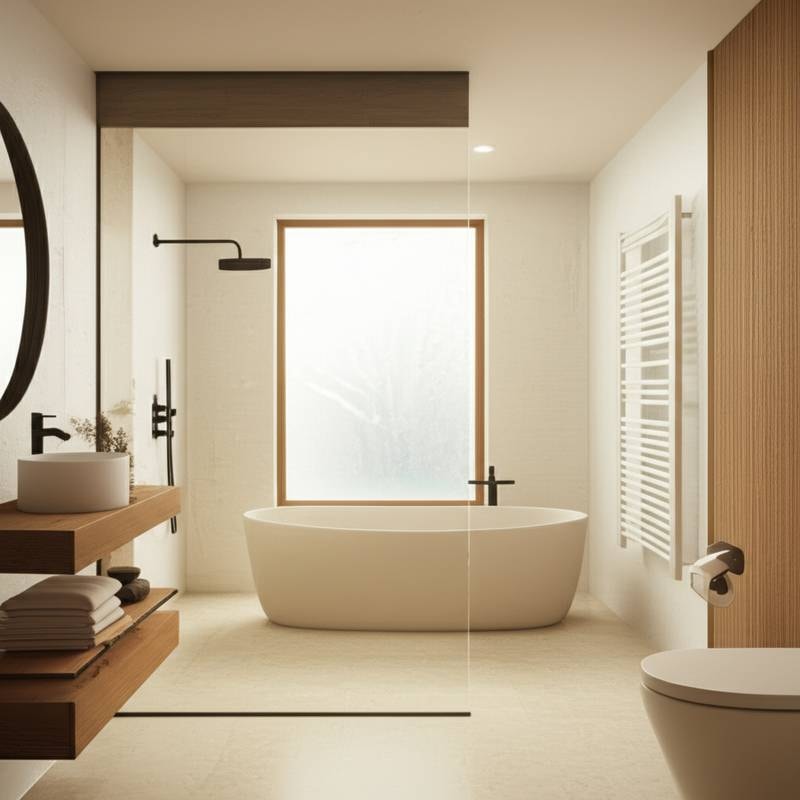Japandi Wet Rooms: The Leading Minimalist Bathroom Trend for 2025
Japandi wet rooms represent a refined fusion of Japanese Zen principles and Scandinavian minimalism, emerging as the premier bathroom design trend for 2025. This approach emphasizes serene, functional spaces that prioritize natural elements and simplicity. Homeowners and designers alike appreciate how these rooms transform everyday bathrooms into tranquil retreats without unnecessary complexity.
Core Elements of Japandi Wet Rooms
Japandi design achieves harmony by combining the organic warmth of Japanese aesthetics with the streamlined functionality of Scandinavian style. In a wet room context, this translates to an open, barrier-free bathing area that enhances both usability and visual appeal. The design promotes a sense of purpose in every detail, fostering peace and personalization.
Wet rooms in this style feature seamless integration of shower and surrounding space, often with a subtle floor slope leading to a central drain. This layout minimizes visual clutter and simplifies maintenance. Materials such as wood accents and stone surfaces contribute to a restorative environment that supports mindful daily routines.
Principles for Achieving Design Simplicity
Success in Japandi wet rooms relies on deliberate restraint in selection and placement. Each element must contribute to the overall calm without overwhelming the space. Consider the following guidelines to implement this effectively:
- Neutral Color Palette: Select soft taupes, warm grays, and off-whites to promote light reflection and spatial openness. These shades create an airy feel, particularly in compact bathrooms.
- Natural Materials: Incorporate bamboo cabinetry, oak vanities, or porcelain tiles mimicking linen textures. Such choices add subtle warmth while maintaining a clutter-free appearance.
- Matte Finishes: Opt for non-reflective surfaces on fixtures and tiles to diffuse light softly, evoking a spa atmosphere. Avoid glossy elements that can introduce harsh contrasts.
- Open Layout: Eliminate traditional shower enclosures in favor of a fully tiled, sloped-floor design. This approach expands the perceived size of the room and streamlines water management.
For budget-conscious updates, apply peel-and-stick wood-effect panels or refresh walls with neutral paint. These modifications yield significant impact with minimal investment.
Budget Strategies for Functional Elegance
Japandi wet rooms accommodate various financial levels while upholding principles of intentional luxury. Focus on elements that enhance usability and well-being rather than extravagance. Below is a structured approach across budget tiers:
- Low Budget: Prioritize cosmetic changes such as painting walls in warm neutral tones and adding bamboo mats or linen towels. Introduce a potted fern for organic texture and vitality.
- Mid-Range Budget: Upgrade hardware with matte black or brushed nickel showerheads and faucets. Install waterproof vinyl flooring that replicates oak grain for durability and authenticity.
- High Budget: Invest in microcement wall applications, built-in stone benches, and frameless glass partitions. Include underfloor heating to elevate comfort in cooler climates.
Intentional selection ensures that even modest pieces, like a thrifted wooden stool, integrate seamlessly and elevate the design.
Enhancing Ambiance with Lighting and Texture
Effective lighting defines the Japandi wet room experience. Maximize natural daylight where possible; in windowless spaces, employ layered artificial sources. Recessed ceiling fixtures paired with upward-facing wall sconces provide even illumination without glare.
For added subtlety, position waterproof LED strips under vanities or along floor edges to create a gentle, ambient glow. Texture complements this by introducing tactile variety. Combine smooth stone flooring with woven storage baskets and linen accents for depth.
Incorporate elements like textured bath mats or artisanal ceramic accessories to balance refinement with approachability. A recent project demonstrated this by limiting the palette to microcement, oak, and matte fixtures, resulting in a cohesive and transformative space.
Sustainability and Practical Maintenance
The appeal of Japandi wet rooms extends to their eco-conscious foundation. By using fewer materials, these designs reduce environmental impact. Renewable options like bamboo and cork flooring support sustainability without compromising aesthetics.
The open configuration simplifies upkeep, eliminating grout scrubbing or curtain maintenance. A daily rinse and wipe suffice for cleanliness. During renovations, integrate recycled glass tiles or salvaged wood to enhance both beauty and ethical value.
Homeowners often find satisfaction in designs that align with planetary stewardship, creating spaces that reflect personal and global responsibility.
Professional Styling Techniques
Strategic contrast elevates Japandi wet rooms visually. Pair light stone floors with darker vanities or introduce matte black accents against white walls for dimension. This technique ensures the space remains balanced yet engaging.
Incorporate greenery judiciously, such as a trailing ivy plant or compact bonsai, to infuse vitality into neutral tones. Humidity in wet rooms supports plant health, adding natural movement.
Accessories should remain sparse: a single wooden perch, stacked towels, or a ceramic vessel suffices to curate a serene vignette. These touches foster a sense of intentional habitation.
Integrating Japandi into Daily Life
A completed Japandi wet room serves as a dedicated haven for relaxation. Maintain its essence by limiting visible items to essentials and concealing storage neatly. Periodic updates, like seasonal linens or fresh plants, keep the space dynamic.
Renters can adopt portable adaptations, including bamboo trays or essential oil diffusers scented with cedar or cypress. These elements evoke the style's core without structural changes.
Ultimately, Japandi's enduring simplicity adapts to evolving needs, ensuring lasting relevance. Embrace this trend to cultivate a bathroom that nurtures balance and tranquility in routine moments.










